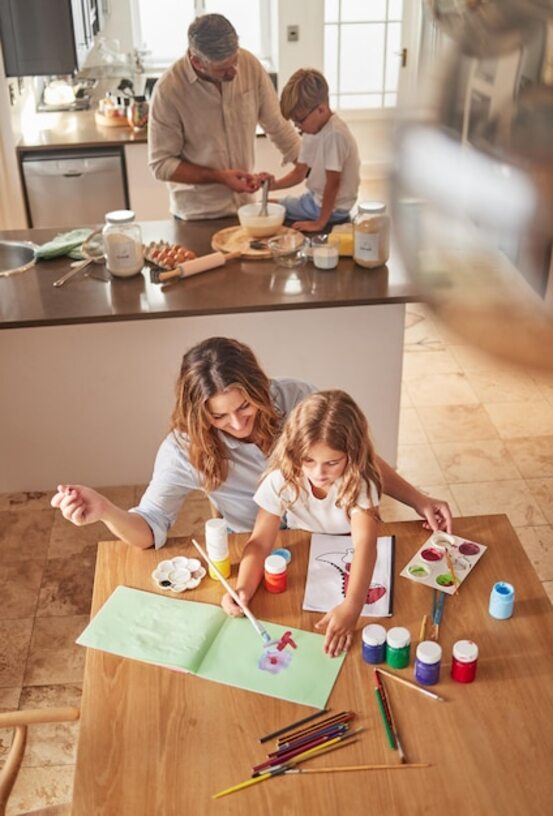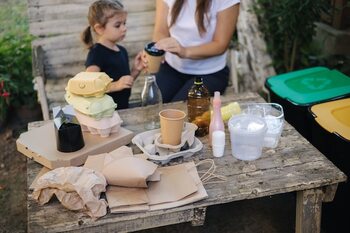Create a home that celebrates the adventure of growing up as a family.

Create a home that celebrates the adventure of growing together as a family and transform your space into a refuge filled with love, laughter, and unforgettable memories. In this article, you will discover how every corner can become a testament to the family journey, where shared moments turn into treasures. With practical and creative tips, you will learn to design an environment that fosters connection among family members, allowing each day to be a new adventure. It’s time to make your home the place where life flourishes!
The importance of creating welcoming spaces for the family
Creating welcoming spaces at home is essential for fostering an environment where the family can grow and thrive. A warm and well-designed space not only invites togetherness but also becomes the perfect setting for sharing laughter, stories, and meaningful moments. From a comfortable living room with cozy sofas to an open kitchen that facilitates interactions during meal preparation, each area should be designed to promote connection among family members. By including personal elements such as photographs, artwork, or travel souvenirs, an environment is created that reflects the unique essence of each family, making every corner tell its own story.
Additionally, a cozy home acts as a refuge from the external pressures of day-to-day life. When spaces are comfortable and harmonious, it fosters an atmosphere of safety and tranquility where everyone can be authentic. The moments shared in these environments are essential for building strong bonds; from family games in the living room to movie nights cuddled together. The importance of these spaces lies not only in their functionality but also in how they influence the emotional and psychological well-being of each member. By investing time and effort in creating a cozy home, you are sowing the seeds for a family life rich in love and connection.
2. Ideas for play areas that stimulate creativity
To create play areas that stimulate creativity at home, it is essential to think of versatile spaces where children can explore their imagination. Consider dedicating a corner of the living room or a specific room to artistic activities and crafts. You can equip this space with small tables, comfortable stools, and shelves filled with materials like paints, colored papers, scissors, and glue. By providing an accessible and inviting environment, you will be encouraging your children to experiment with different techniques and projects, which not only fosters their creativity but also allows them to express themselves freely.
Another idea is to incorporate interactive play elements that promote collaboration and group learning. Structures like tree houses, tents, or even a cozy reading nook can be ideal for fostering collective imagination. Encourage your children to design their own spaces within the home where they can play at being explorers, scientists, or artists. These nooks not only provide opportunities to develop social skills while playing together, but they also become perfect settings for storytelling and sharing unforgettable family moments. With these ideas, your home will transform into a true sanctuary of creative adventures.
3. How to integrate family memories into decoration
Incorporating family memories into your home decor is a wonderful way to celebrate the stories and moments that have shaped your family. Start by selecting meaningful photographs that capture special moments: from memorable vacations to family celebrations. Frame these images in coordinated frames or create a photo wall on a prominent wall, allowing the memories to tell their own story while beautifying the space. You can also include personal items, such as vintage toys, favorite books, or travel souvenirs, that evoke emotions and personal anecdotes. Each piece becomes a trigger for memories, creating a warm and inviting atmosphere where every family member can feel connected.
Another creative idea is to design themed corners within the home that reflect the family’s passions and hobbies. For example, if your family loves hiking, consider dedicating a shelf to display trophies and mementos from past excursions along with maps marked with the explored routes. For those shared artistic moments, you could have a space to showcase artwork created by your children or even a chalkboard where everyone can leave messages and drawings. This way, each decorative element will not only serve to beautify the home but will also encourage conversations and connections among family members, making each day a celebration of their adventures together.
4. Multifunctional spaces: adapting your home to family needs
Multifunctional spaces are a key essential for adapting to the changing needs of the family. As children grow, their activities and passions evolve, and it is crucial for the home to adjust to these changes. For example, an area that was previously used as a playroom can be transformed into a space for studying or practicing hobbies. By incorporating modular furniture, such as sofa beds or extendable tables, you can maximize the use of space without sacrificing comfort or aesthetics. Thus, every corner of your home not only becomes a practical place but also an environment that fosters creativity and family collaboration.
The key to achieving multifunctional spaces lies in smart planning and design. Consider using room dividers like open shelves or decorative curtains to create specific areas within the same room. This not only helps to maintain order but also allows for the establishment of zones where each family member can enjoy their own activities, from reading to playing video games. Additionally, don't forget to include versatile elements like decorative storage boxes or tables that serve both for dining and for crafting. By adopting this flexible approach to home design, you will be creating an adaptable haven that celebrates the various stages of family growth while nurturing the bonds among all its members.
5. The magic of family traditions and their reflection in the home
Family traditions are the thread that connects each family member, creating a sense of belonging and continuity. From festive dinners to holiday rituals, each tradition adds a special touch to the home. By incorporating elements that reflect these customs into your space, such as specific decorations or a dedicated table for family gatherings, a warm and welcoming atmosphere is generated where everyone feels valued. These details not only beautify the home but also serve as tangible reminders of shared moments and teachings passed down from generation to generation.
Additionally, traditions can be adapted and evolved over time, allowing each new family member to bring their own spark to the celebration. Creating a family mural with photos of these activities can be an excellent way to keep those memories alive and share stories among younger generations. This type of interaction not only fosters emotional connection among household members but also transforms the space into a vibrant refuge where every corner tells a story. Thus, by celebrating family traditions within the home, one contributes to forging an environment filled with love, laughter, and constantly growing adventures.
6. Sustainability: creating an environmentally friendly home
Sustainability has become a fundamental pillar for those seeking to create a home that not only celebrates family growth but also respects and protects our planet. Adopting environmentally friendly practices not only benefits the Earth but also teaches the youngest members the importance of caring for our environment. From choosing recycled materials and sustainable furniture to implementing energy-saving systems, every conscious decision can turn your home into an example of ecological responsibility. Involve the whole family in these decisions; this way, they will learn together to value and preserve what surrounds us.
You can also choose to create a family garden where everyone participates in the care of plants and vegetables. This space will not only provide fresh food but will also become a place for connection and learning about nature. Creating compost is another excellent way to teach children about recycling and waste reduction while they see how their waste transforms into nutrients for the plants. At the end of the day, a sustainable home not only contributes to the well-being of the planet but also strengthens family ties by encouraging joint activities that enrich their shared experience.
7. The influence of color on family emotional growth
Color has a profound impact on our emotions and, therefore, on family dynamics. Warm colors like yellow or orange can foster joy and optimism, creating an environment where laughter and conversations flow naturally. On the other hand, softer tones like blues or greens invite calm and reflection, creating ideal spaces for sharing moments of tranquility with family. When choosing the colors for each room, consider how you want your loved ones to feel in those spaces; each hue can influence their emotional state and the quality of their interactions.
It is also essential to involve all family members in the color selection process. This not only gives them a sense of belonging to the home but also allows each person to express their preferences and feelings. Including favorite colors or those that represent shared experiences can create an even stronger emotional bond among the household members. Remember that a visually harmonious environment not only beautifies your space but also nurtures family relationships by fostering an atmosphere where everyone feels comfortable and valued.
8. Designing reading nooks to foster imagination
Designing reading nooks at home is a wonderful way to encourage imagination and a love for books in the whole family. Imagine a cozy space, with soft pillows, warm blankets, and shelves filled with stories waiting to be explored. These types of nooks not only promote reading but also serve as a refuge where family members can immerse themselves in fantastic worlds or learn about new cultures and concepts. By creating an environment that stimulates curiosity, you help your loved ones develop their creativity and critical thinking, turning each reading session into an exciting adventure.
To design these magical spaces, consider elements like good lighting, whether natural or through warm light lamps. Soft colors and themed decorations related to books can make the corner even more appealing. Adding interactive elements like drawing boards or world maps can inspire fascinating conversations about the stories read. Remember that a reading nook is not just a place to read; it is a site where shared memories are built, family bonds are forged, and progress is made together in the adventure of knowledge and imagination. Let each book open new doors to unforgettable experiences!
9. DIY projects to involve the whole family
Involving the whole family in DIY (do-it-yourself) projects is not only a great way to foster creativity, but it also strengthens family bonds. From building a treehouse to creating a community garden, each project offers a unique opportunity to collaborate and learn together. Working side by side not only develops practical skills but also creates shared memories that will last over time. Consider dedicating one day a week or a month to embark on a new project; that way, everyone will have something exciting to look forward to and enjoy.
DIY projects can be adapted to the different ages and interests of family members. For example, younger children can participate in simple activities like painting pots or making crafts with recycled materials, while teenagers can take on more complex tasks such as home decoration or creating custom furniture. Setting achievable goals and celebrating each accomplishment —no matter how small— can transform these moments into meaningful experiences where every voice matters and feels valued. At the end of the day, the most important thing is the time spent together, and what better way to do it than by creating something special for your home!
10. How to turn household chores into fun and collaborative activities
Transforming household tasks into fun and collaborative activities is an excellent way to strengthen family bonds while keeping the home in order. Instead of viewing cleaning, cooking, or gardening as chores, you can turn them into games. For example, organize friendly competitions to see who can pick up the most toys in a set amount of time or create a "cooking club" where each family member takes turns choosing a recipe and cooking together. By associating these tasks with fun and creativity, they not only become more manageable but also create shared memories that will last.
It is essential to involve all family members, regardless of their age. The youngest can learn about responsibility by helping to sort laundry or plant flowers, while teenagers can take on more complex tasks like planning a family meal or managing a home renovation project. Working together towards a common goal fosters team spirit and promotes a sense of belonging within the home. Remember that what matters is not only completing tasks but enjoying the process and celebrating achievements together, turning each day into a new opportunity to grow and laugh as a family.



